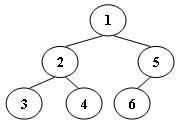An inorder binary tree traversal can be implemented in a non-recursive way with a stack. For example, suppose that when a 6-node binary tree (with the keys numbered from 1 to 6) is traversed, the stack operations are: push(1); push(2); push(3); pop(); pop(); push(4); pop(); pop(); push(5); push(6); pop(); pop(). Then a unique binary tree (shown in Figure 1) can be generated from this sequence of operations. Your task is to give the postorder traversal sequence of this tree.

Figure 1
Input Specification:
Each input file contains one test case. For each case, the first line contains a positive integer N (≤30) which is the total number of nodes in a tree (and hence the nodes are numbered from 1 to N). Then 2N lines follow, each describes a stack operation in the format: "Push X" where X is the index of the node being pushed onto the stack; or "Pop" meaning to pop one node from the stack.
Output Specification:
For each test case, print the postorder traversal sequence of the corresponding tree in one line. A solution is guaranteed to exist. All the numbers must be separated by exactly one space, and there must be no extra space at the end of the line.
Sample Input:
6
Push 1
Push 2
Push 3
Pop
Pop
Push 4
Pop
Pop
Push 5
Push 6
Pop
Pop
Sample Output:
3 4 2 6 5 1
solution:
#include<bits/stdc++.h>
using namespace std;
#define endl '\n'
typedef long long ll;
int n;
typedef struct node *tree;
struct node
{
int val;
tree left,right;
};
const int maxn=1e5+5;
int pre[maxn],in[maxn];
int cnt1=0,cnt2=0;
vector<int>ans;
tree build(int pre[],int in[],int n)
{
if(!n)return NULL;
tree root=new node;
root->val=pre[0];
root->left=root->right=NULL;
int i;
for(i=0;i<n;i++)
{
if(pre[0]==in[i])break;
}
root->left=build(pre+1,in,i);
root->right=build(pre+1+i,in+1+i,n-i-1);
return root;
}
void postorder(tree t)
{
if(t==NULL)return;
postorder(t->left);
postorder(t->right);
ans.push_back(t->val);
}
void output()
{
//cout<<ans.size()<<endl;
for(int i=0;i<ans.size();i++)
{
if(i)cout<<' ';
cout<<ans[i];
}
}
int main()
{
cin>>n;
stack<int>st;
for(int i=1;i<=2*n;i++)
{
string s;cin>>s;
if(s=="Push")
{
int t;cin>>t;
pre[cnt1++]=t;
st.push(t);
}
else
{
int tmp=st.top();st.pop();
in[cnt2++]=tmp;
}
}
//for(int i=0;i<n;i++)cout<<pre[i]<<' ';cout<<endl;
//for(int i=0;i<n;i++)cout<<in[i]<<' ';cout<<endl;
tree root=new node;
root=build(pre,in,n);
postorder(root);
output();
}
单纯的依靠前序和中序建后序




















 1492
1492

 被折叠的 条评论
为什么被折叠?
被折叠的 条评论
为什么被折叠?








